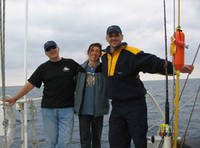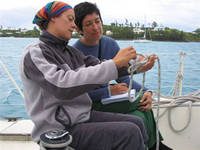May 13, 2005
Ready to cross the Atlantic. Friday, May 13th, 2005
Today, three new crew members joined the Ranger to “commit” the crossing of the Atlantic. They are Xavier Pastor, Eduardo de Ana and Alicia Fraile. Xavier, a marine biologist, is the Director of the Oceana office in Europe, from where he spearheaded the Transoceanic Expedition, with enthusiastic support from Steven and Annie MacAllister, owners of the catamaran we are sailing in now. Xavier had already been onboard during March and April, in the previous leg of the crossing, which included Costa Rica, Panama and Honduras. This is a territory he is very familiar with, because of his prior work implementing the Mar Viva Foundation , an organization that works in defense of illegal fishing, out of those countries.

Eduardo de Ana “Guayo” is responsable for Oceana’s European webpage. Thanks to his work at the Madrid office, thousands of people around the world may be reading this diary at this very moment, enjoying the underwater videos filmed by Mar Mas and the extraordinary photos taken by Houssine Kaddachi, Sole Esnaola and other companions from the crew, throughout different steps of the expedition. Among them, I can name Sandy Mayson and Maribel López (who preceeded me in writing this journal), Annie Compton, Juan Pablo Camblor and Ines García Fungairiño, from ZOEA , Jose Indi Peñalver, Aitor Iturraspe, Nuño Ramos y so many others who will join the crew of the Ranger through this crossing.
The third new member who just came onboard in this crew turnover in Bermudas is Alicia Fraile, expert sailor and an old friend from prior experiences in defense of the environment, working onboard Greenpeace’s ships, like the sailboat Zorba. In addition to being Oceana volunteers, Alicia and Jose Peñalver are founding members of the Sociedad de Historia Natural del Mar and active members in the group Ecovoz
There was crew turn over at the Ranger, because the crossing is long and at times, exhausting. Some members, lilke Mar and David, have been onboard since much before the catamaran officially left Los Angeles, last January 17th. Others, like Sole or Houss, are also record keepers in permanency onboard. Ricardo Aguilar and I go back to the Oceana office in Madrid to resume on terra firma the work on Research and Projects, and I will resume work in the area of Communication. From Madrid we will follow closely the Ranger’s course, however, this time we will not be unable to keep the computer steady because of the surf movements, and we will not have to struggle to keep our clothes dry every time Carlos Perez, the first officer or the sailor Bibi Alvarez took us ashore on the auxiliary raft.
 Before saying goodbye to the Ranger, I still have a lesson on knots to take from Bibi. No one can become a true sailor without knowing at least four of them: the square knot, figure 8 knot, clove hitch, and bowline. As the rope expert that she is, this sailor from Combados is an “artist” at handling knots. (In marine terms, we do not say “lines” but the precise term is “ropes”). The only line on a ship may be hanging from a clock or it may be strings we tie our shoes with. At the same time, ropes can be made of fiber, synthetic material, polyester, nylon, etc. Their names vary in relation to their purpose: halyard; used to raise or lower a sail, escotas; which run along the edges, used for changing the sails; and the moorings. “The important thing is-she explains-that the knot must be strong, resistant, and be able to be undone later, because the nitre will.. “azoca”. The marine term Bibi uses means that the nitre tightens the knots and then it is practically impossible to untie them, which would be inoperative on a ship.
Before saying goodbye to the Ranger, I still have a lesson on knots to take from Bibi. No one can become a true sailor without knowing at least four of them: the square knot, figure 8 knot, clove hitch, and bowline. As the rope expert that she is, this sailor from Combados is an “artist” at handling knots. (In marine terms, we do not say “lines” but the precise term is “ropes”). The only line on a ship may be hanging from a clock or it may be strings we tie our shoes with. At the same time, ropes can be made of fiber, synthetic material, polyester, nylon, etc. Their names vary in relation to their purpose: halyard; used to raise or lower a sail, escotas; which run along the edges, used for changing the sails; and the moorings. “The important thing is-she explains-that the knot must be strong, resistant, and be able to be undone later, because the nitre will.. “azoca”. The marine term Bibi uses means that the nitre tightens the knots and then it is practically impossible to untie them, which would be inoperative on a ship.

The figure 8 knot is a very simple knot to make and it is used to anchor. The square knot, to tie two ropes of the same “thickness”, that is, of the same type, because-the teacher insists “there are non compatible knots if done with a different rope”. Perhaps the most useful of all knots is the clove hitch. It can be useful to tie the boat upon docking and also for hoisting a sail. The bowline knot for instance, is very useful to tie in the protections that run along the ship to keep it from hitting against the docks or against other ships when docking in tight spots (when the boats dock side by side). “But choosing the type of knot to use will depend on the purpose and where they must be tied, the type of vessel, the speed needed for the operation or, for instance, on the tension the rope will be subjected to”.
I will take some rope with me to Madrid to practice what I have learned in this very interesting lesson, which I hope will not the last onboard the Ranger. From Bermudas, the Oceana Expedition will proceed en route to European waters next Sunday, arriving in Azores, if the winds are favorable, at the beginning of June. The Oceana crew members still have another 4.000 miles of navigation ahead of them, equally tense and exciting as it has been so far. When our catamaran reaches its final destination in the Mediterranean, it will have left a trail of 11,000 nautical miles behind.


